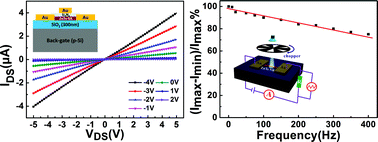Device structure-dependent field-effect and photoresponse performances of p-type ZnTe:Sb nanoribbons
Abstract
Sb-doped ZnTe

* Corresponding authors
a
School of Materials Science and Engineering, Hefei University of Technology, Hefei, Anhui 230009, P. R. China
E-mail:
apjiang@hfut.edu.cn
b
School of Electronic Science and Applied Physics, Hefei University of Technology, Hefei, Anhui 230009, P. R. China
E-mail:
jason.jsjie@gmail.com
c Institute of Functional Nano & Soft Materials (FUNSOM), Soochow University, Suzhou, Jiangsu 215123, P. R. China
Sb-doped ZnTe

 Please wait while we load your content...
Something went wrong. Try again?
Please wait while we load your content...
Something went wrong. Try again?
D. Wu, Y. Jiang, Y. Zhang, J. Li, Y. Yu, Y. Zhang, Z. Zhu, L. Wang, C. Wu, L. Luo and J. Jie, J. Mater. Chem., 2012, 22, 6206 DOI: 10.1039/C2JM16632A
To request permission to reproduce material from this article, please go to the Copyright Clearance Center request page.
If you are an author contributing to an RSC publication, you do not need to request permission provided correct acknowledgement is given.
If you are the author of this article, you do not need to request permission to reproduce figures and diagrams provided correct acknowledgement is given. If you want to reproduce the whole article in a third-party publication (excluding your thesis/dissertation for which permission is not required) please go to the Copyright Clearance Center request page.
Read more about how to correctly acknowledge RSC content.
 Fetching data from CrossRef.
Fetching data from CrossRef.
This may take some time to load.
Loading related content
